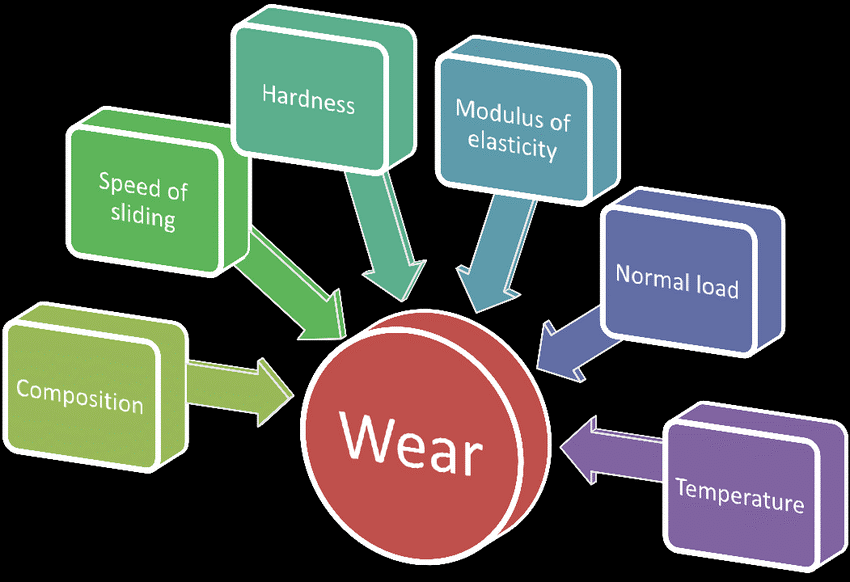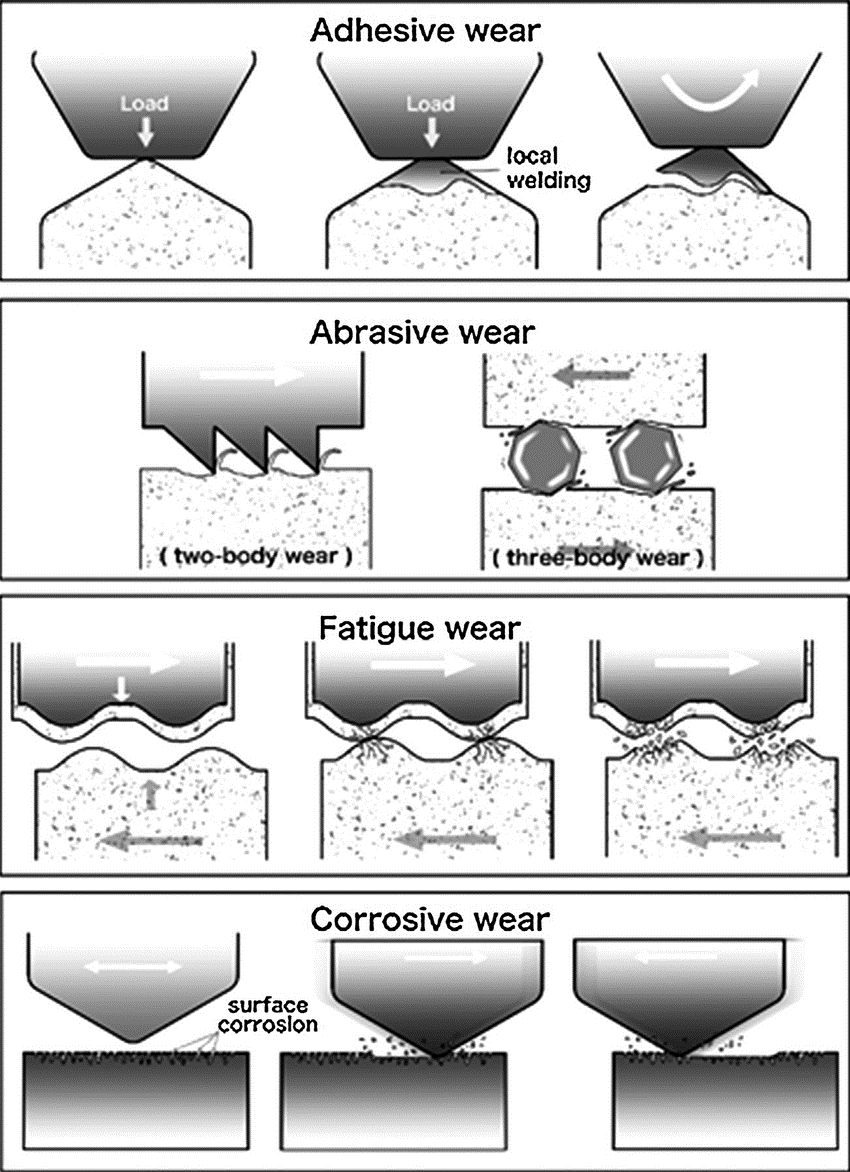I'm an Erasmus Mundus Scholarship recipient in the field of Tribology of Surfaces and Interfaces. The masters program takes place in four different universities namely University of Leeds (UK), University of Ljubljana (Slovenia), University of Coimbra (Portugal) and Lulea Technical University (Sweden).
Wear
Table of Contents
Definition of Wear:
Wear is defined as surface damage of one or all solid surfaces in contact subject to relative motion. Wear might have different patterns corresponding to various wear mechanisms. A surface can be subject to more than one wear mechanism simultaneously such as it can have adhesive and corrosive wear or abrasive and fatigue wear or a combination of several of these. The process of wear can change continuously in time or with changes in operational conditions. Wear is usually accelerated by frictional heating by means of chemical and mechanical interactions.
Factors affecting Wear:
The key factors influencing wear are temperature, sliding speed, hardness, modulus of elasticity, load, and composition of material. The wear resistance is influenced by the contact temperature [1]. Since the hardness and yield strength diminish as the temperature rises [2] abrasive wear would increase. The yield strength and hardness for most of the materials diminishes as the temperature rises. At elevated temperatures the dislocation movement in metals causes a drop in yield strength, making plastic deformation simpler. The wear rate is substantially influenced by the normal load. With an increase in the load applied, the shear force and frictional thrust rise as well, speeding up the wear rate [3]. In the range of 0 to 2.5 m/s sliding speed, the rate of abrasive wear increased marginally. Frictional heating [8] may be to blame for the increase in wear. We cannot generalise that the increase in sliding speed would definitely increase wear as it also depends on the load being applied on the surfaces, presence of lubricant and the surface roughness of the contacting bodies. The elastic modulus is an indicator of the material’s resistance to deformation under load, with a larger number indicating more stiffness [4]. The materials’ composition also has a significant impact on wear behaviour for example in composites, it’s mechanical behaviour can be affected based on the concentration of inorganic fillers [5]. The presence of organic matrix which is responsible for low resistance to wear can be reduced by the introduction of this inorganic fillers [18].

Fig-1 Factors affecting Wear [5]
Wear mechanisms:
Many researchers have attempted to classify the wear mechanisms [6-8] and few classification schemes are available in the literature [9]. Mechanisms of wear according to Ludema [10] are “the succession of events whereby atoms, products of chemical conversion, fragments are induced to leave the system (perhaps after some circulation) and are identified in a manner that embodies or immediately suggests solutions”. There is a wide range of terms (for instance adhesive, abrasive, fretting, surface fatigue, corrosion, erosion) available for the description of wear mechanisms [10, 11], but at least four groups can be distinguished [12]:
3.1 Adhesive wear:
Adhesive wear is the undesired movement and adhesion of wear debris and material compounds from one surface to another that occurs in frictional contact between surfaces. When the atomic forces between the materials in contacting surfaces under relative pressure are greater than the inherent material properties of each surface, adhesive wear develops. [19]
3.2 Abrasive Wear:
When a hard, rough surface glides across a smooth surface, abrasive wear develops. [13] It is defined by ASTM International as material loss caused by hard particles that are pressed against and slide over a solid surface. [14]
The abrasive wear mode is dictated by the type of contact and there’re two types of abrasive wear namely two-body and three-body wear. When hard particles remove material from one surface, this is known as two-body wear. When particles are not restricted and are allowed to roll and glide along a surface, three-body wear develops.
3.3 Corrosive wear:
Corrosive wear is indeed an indirect wear mechanism that occurs when a sliding surface is exposed to a corrosive medium and the sliding movement continuously eliminates the preventive corrosion product. As a result, the new surface is exposed to additional corrosive damage. Since this removes corrosive products and the passive protective layer faster than surfaces without any relative motion, corrosion wear could be regarded an accelerated process for corrosion. [20]
3.4 Surface fatigue:
Surface fatigue occurs due to the growth and formation of cracks. It is a kind of basic material fatigue in which the material surface weakens as a result of cyclic loads.

Fig-2 Wear Mechanisms [15]
Wear Reduction Methods:
We all understand that wear can only be mitigated, not prevented. We can minimize wear, but we won’t be able to eradicate it. Many strategies have been devised to minimize wear, as detailed below. [16]
4.1 Prevention of Overloading:
Overloading should be avoided since it causes lubricants to break down and puts an excess force on the worn surface.
4.2 Maintain a Proper Clearance:
When the clearance between the surfaces is too small, a lubricating oil layer cannot be applied to the worn surface, resulting in metal-on-metal contact. If there is more space between the surfaces, motion is lost. Due to the sheer absence of lubrication, the machine’s parts wear down quickly, making it loud and vibrating.
4.3 Better Lubrication:
Lubrication produces a lubricant film in the space between the contacting surfaces, which improves its smoothness and avoids material contact. Improper lubrication leads to wear of surfaces.
4.4 Improving the Surface Finishing:
Various sorts of straight or circular lays are formed when parts are passed through the machining process, that cannot be seen with the human eye. Because of the good surface, a line contact rather than a point contact is created, which is advantageous in processes. Good surface finish uniformly distributes load rather than maintaining asperity contacts leading to reduction of wear.
4.5 High Surface Hardness:
In compared to soft surfaces, hard surfaces wear down faster. Heat treatment is used to enhance the surface hardness of the shaft, bearing, and guide way, which reduces wear.
4.6 Proper Surface Treatment:
Mechanical wear can be minimized by applying a hard coating of metal, such as chromium or galvanic, on the surface. As a result, it may be argued that if a hard layer is applied to the surface of a wear-resistant metal, the part’s wear can be minimized.
4.7 Protection of Surface Against the Ingress of Dirt, Dust and Metal Particles:
If debris, dirt, or metal particles get inside the bearings, they get crushed much more. If the particles are tougher than the surface of the part, the surface will wear down and gets damaged.
4.8 Proper Atmosphere:
Dust, debris, moisture, dangerous chemical vapour are all present in the atmosphere, affecting machining operations and reducing their service life.
Several other techniques for wear reduction include proper maintenance, varying clearance adjustments over time, good planning, integration of preventive maintenance, controlling the preventive maintenance tasks, selection of appropriate material for the component, reducing sliding pairs with the replacement of rolling pairs, and using a fully automated maintenance facility [17].
References:
- Rymuza , “Tribology of Polymers”, Archives of Civil and Mechanical Engineering, Vol. VII, No. (4), pp. 177- 184,(2007).
- ASM International, ASM Handbook Volume 18, “Friction, Lubrication, and Wear Technology”, American Society for Metals, Metals Park, Ohio, pp. 341-347, (1992).
- Nuruzzaman, D.M., Chowdhury, M.A., and Rahaman, M.L. “Effect of Duration of Rubbing and Normal Load on Friction Coefficient for Polymer and Composite Materials”, Industrial Lubrication and Tribology, Vol. 63, pp. 320 – 326, (2011).
- Lu H., Lee Y., OguriM, Powers J., “Properties of a Dental Resin Composite with a Spherical Inorganic Filler”, Operative Dentistry, Vol.31, No. 6, pp.734-740, (2006).
- , Meshref & A., Mazen & A., and & Y., Ali. (2020). WEAR BEHAVIOR OF HYBRID COMPOSITE REINFORCED WITH TITANIUM DIOXIDE NANOPARTICLES. 39. 89-101. 10.21608/jaet.2020.75738.
- Blau, P.J. Friction and Wear Transitions of Materials. New Jersey: Noues Publications, 1989.
- Knowels, G.D. Mechanisms of Wear Particle Formation and Detachment. Vancouver: The University of British Columbia, 1994.
- Ludema, K. A Textbook in Tribology. Ann Arbor: CRC Press, 1996.
- Bhushan, B. Principles and Applicaion of Tribology. New York: A Wiley-Interscience Publication, 1999.
- Wear Patterns and Laws of Wear – A Review. Zmitrowicz, A. 2006, Journal of Theoretical and Applied Mechanics, pp. 219-253.
- van Drogen, M. The Transition to Adhesive Wear of Lubricated Concentrated Contacts. Enschede: University of Twente, 2005.
- Classification of Wear Mechanisms/Models. Kato, K. 2002, Journal of Engineering Tribology, pp. 349-355.
- Rabinowicz, E. (1995). Friction and Wear of Materials. New York, John Wiley and Sons.
- Standard Terminology Relating to Wear and Erosion, Annual Book of Standards, Vol 03.02, ASTM, 1987, p 243-250
- Tsujimoto, Akimasa & Barkmeier, Wayne & Erickson, Robert & Nojiri, Kie & Nagura, Yuko & Takamizawa, Toshiki & Latta, Mark & Miazaki, Masashi & Fischer, Nicholas. (2017). Wear of resin composites: Current insights into underlying mechanisms, evaluation methods and influential factors. Japanese Dental Science Review. 54. 10.1016/j.jdsr.2017.11.002.
- K. Dodiya, J. P. Parmar, A Study of Various Wear Mechanism and its Reduction Method, International Journal for Innovative Research in Science & Technology, Volume 2, Issue 09, February 2016, ISSN (online): 2349-6010.
- Book of Plant maintenance and safety by K.K.Patel.
- Aljosa I., Tijana L., Larisa B., Marko V., Influence of Light-Curing Mode on the Mechanical Properties of Dental Resin Nanocomposites, Procedia Engineering, Vol. 69, pp. 921–930, (2014).
- “Adhesive Wear.” Wikipedia, 16 September 2021, https://en.wikipedia.org/wiki/Wear#Adhesive_wear
- “Tribocorrosion.” Wikipedia, 14 June 2020, https://en.wikipedia.org/wiki/Tribocorrosion

Be the first to comment